Text

“Arid Wanderer”
Amidst a drought Patagornis, a terror bird, wanders about in search of prey. a hard task in a desolate land.
111 notes
·
View notes
Text
Angling in Teyvat: a Glimpse into Aquatic Life across the Continent

From the vast freshwater rivers of Sumeru to the dark depths of Inazuma, aquatic life is diverse and widespread in Teyvat. Some that are common and widely available in fish markets and ponds, and others that only a handful of people have even seen alive in their natural habitat.
Hope you liked this mini series, I might make more if y'all want it :>
#art#illustration#speculative evolution#clip studio paint#fanart#genshin impact#fish#fishing#bass#marlin#axolotl#guppy#pufferfish#pike#paddlefish#angelfish
512 notes
·
View notes
Text
Angling in Teyvat
Part Six: The Dragonoid Kois
An oddity among the various fish that are commonly known among anglers, the Dragonoid Kois (Longfilius sp.), are strange fully aquatic amphibians that can be found across Tevyat, and whose reputation varies depending on the species you're talking about.

Although they are amphibians, they can survive extended periods of time in saltwater, with various fishermen having reported them miles off the coasts of some Inazuman islands. This is thought to be one of the reasons why they're so widespread throughout the continent without effective egg dispersal methods like those of Anthoryzias, since they are anadromous late breeders with very sensitive brood.
They are predatory, using suction to capture surprisingly large prey, half as big as the whole individual, to be swallowed whole. However they are known to scavenge often, as their kills are often stolen since they take very long to swallow large prey.
Two species are recognised in this genus, with, as previously mentioned, very different reputations. The one which is worst viewed by people is the now called "False Dragon", the Golden Koi (L. debilis). Unlike its relative, this species is pretty sensitive to environmental disturbances, scavenges frequently and only consuming comparatively small prey, due to its lack of ability to defend prey. Viewed as a "Disgrace to the Dragon lineage", they are very important for the environments they live in, as they are key in cleaning up the ecosystem of large carcasses and control of aquatic pests or invasive species, like the Petalfin Medaka.
#art#illustration#speculative evolution#speculative biology#fanart#clip studio paint#genshin impact#amphibian#axolotl
29 notes
·
View notes
Text
Angling in Tevyat
Part Three: The Petalfin Medakas
Practically ubiquitous in every body of water in Tevyat, the Petalfin Medakas (Anthoryzias sp.) are not only a popular ornamental fish which can be found in ponds and aquariums in every region, but a staple of cuisine from almost every region and the first catch of many aspiring fishermen.
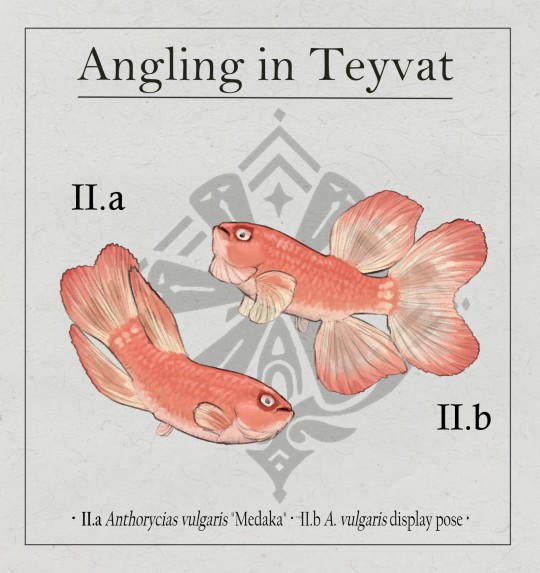
These fish are extremely adaptable, being able to tolerate an astounding range of water conditions, making them not only excellent colonizers of foreign environments, but also for captivity and farming. They are mostly found in freshwater and brackish environments, but some species are catadromous, living in freshwater and migrating to coastal waters to breed, although this can even vary between populations of the same species.
The most common and widespread species is the Common Medaka (Anthoryzias vulgaris). The true native region of this species is unknown, as thanks to the ancient custom of using this fish an an ornamental and farming fish thanks to its low requirements, it has escaped multiple times and colonized pretty much every known waterway and pond in every region.
11 notes
·
View notes
Text
Angling in Teyvat
Part Two: The Regal Butterflyfish
One of the most frequent captures one might encounter in the waters of Teyvat are members of the Regal Butterflyfish family (Thalattoreginidae sp.). These fish are very adaptable and resilient, being almost widespread throughout the continent, being only absent from the region of Fontaine, supposedly from its isolation from the rest of Teyvat's water bodies. And although most species can be found in continental water bodies, some species have been able to adapt and spread throughout the Inazuma archipelago.

All species have not only electroreceptors along their bodies, but an electric organ at the base of the dorsal fin able to generate electric charges of various intensities depending on the species. They use these electric capabilities for a plethora of purposes, from detecting prey hidden in sediment or vegetation to communication between individuals to form large coordinated shoals.
Two genera are classified within this family, the more common and well known "Queens of the Waves" (Thalattoregina sp.) and the elusive and mythical Angelfish (Thalattoimperatrix sp.). The latter include three species, including the supposedly extinct Moonfish, and its also Inazuman relative the Raimei Angelfish (T. profundus). This fish is a deep-water species that is rarely if ever seen or caught in most of the archipelago thanks to this habitat preference. However, they can be frequently encountered in one ominous place: Kannazuka.
The habits of this species has given it the most acute electroreceptive capabilities of the family, and so it is attracted to high electrical charges in the water. This is why in Kannazuka they go into much shallow waters than they usually migrate to every night attracted by the war torn shipwrecks that have left the water saturated with electrical charge. It is said that they are "risen from the depths by the might of the Shogun" because of this. Because of the area they can be fished in, not many fishermen have had the opportunity to see one of these alive, although it is used in some scientific experiments thanks to its amazing sensitivity to electricity.
17 notes
·
View notes
Text
Angling in Teyvat
Part One: The Fruit Anglers
Common throughout the region of Sumeru, of which they are endemic, the Fruit Anglers (Voracarpus sp.) are one of the species one can expect to catch when fishing in pretty much every freshwater body of the region, from its main navigable rivers to oases and other small isolated water bodies much further inland.
Natural bottom dwellers, they use their cartilaginous protrusions to dig burrows, nests and trenches to look for prey hidden in the mud. But they are just as useful for protection against predators that, combined with the cutaneous chemical defenses of some species, so precaution is adviced when handling members of this species.

One of the rarest most priced species is the so called "Peach of the Deep Waves", Voracarpus persicoides. This unique species is endemic to the pools of water that accumulate up in the canopy of the Lokapala Jungle. Because of its predator free environment, it has lost the chemical defenses a lot of its relatives have evolved, and so its taste is said to be surprisingly sweet, since the sweetness of its crustacean diet is not overshadowed by bitter chemicals in the flesh. Because of its inaccessible habitat and the difficulty of making a dish out of them, not many fishermen have seen a wild specimen in their lives, only captive bred ones ornamental ponds and aquariums.
#art#illustration#speculative evolution#speculative biology#clip studio paint#fanart#genshin impact#genshin fanart#fish#fishing#freshwater fish#pufferfish
27 notes
·
View notes
Text
"Eye of The Ningen"
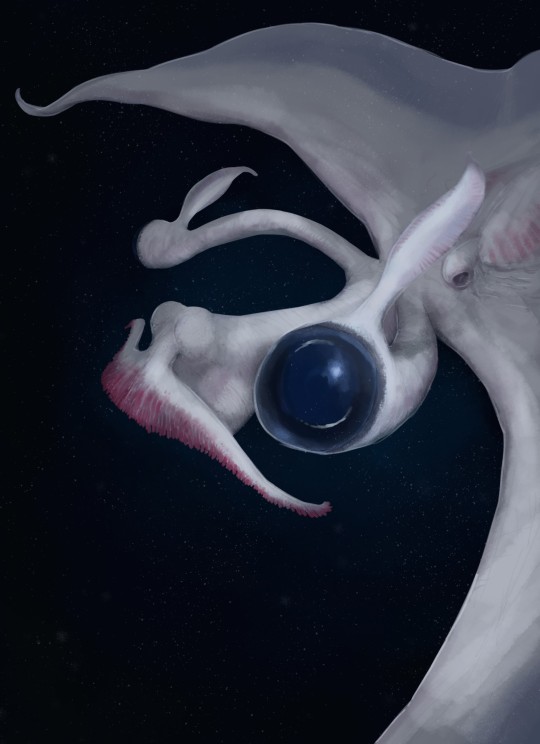
In the waters near the Southern Ocean, a Chilean research ship deploys a deep-sea rover near Point Nemo, almost 3000 kilometres away from the nearest coastline. After a slow and uneventful descent, at 2,213m, something enters the field of view of the camera.
A large white creature is illuminated by the lights of the rover; first what looks like a proboscis topped with bristly appendages, and then a mantaray like body so large it completely covers the entire field of view of the camera. At the base of the proboscis, enormous staked eyes are extended at the camera as it swims by, curious of the unusual sight of light down there.
The creature disappears into the deep as fast as it appeared, like a gigantic aquatic ghost, leaving everyone on board of the vessel astonished.
The creature was absolutely titanic, e destimated to be 15 meters long with a wingspan of at least 20 meters, although estimates may be inaccurate since the whole wingspan couldn't be observed. Its eyes are the biggest of any organism ever seen, almost a meter in diameter. These characteristics may make it a contender for largest animal currently alive.
Its unusual anatomy made it surprisingly easy to identify the creature as a mollusk, specifically a gastropod, although its affinity to other gastropod groups is uncertain. It appears to be a filter feeding, catching food particles from the water using its unusual proboscis. It appears to be shell-less, or at least have a very reduced shell, since no external shell could be identified.
Shortly after the expedition, a paper was published describing this new megafaunal species and naming it as Bathobasileus aetherius, called the "Ningen" by the researchers, as it is speculated to be the origin of the myth of this oceanic cryptid.
#art#speculative evolution#illustration#speculative biology#speculative#cryptid#cryptozoology#ningen#clip studio paint
73 notes
·
View notes
Text
I've been playing too much pikmin that I've started to make my own pikmin concepts


265 notes
·
View notes
Text
"Moss Man Encounter"
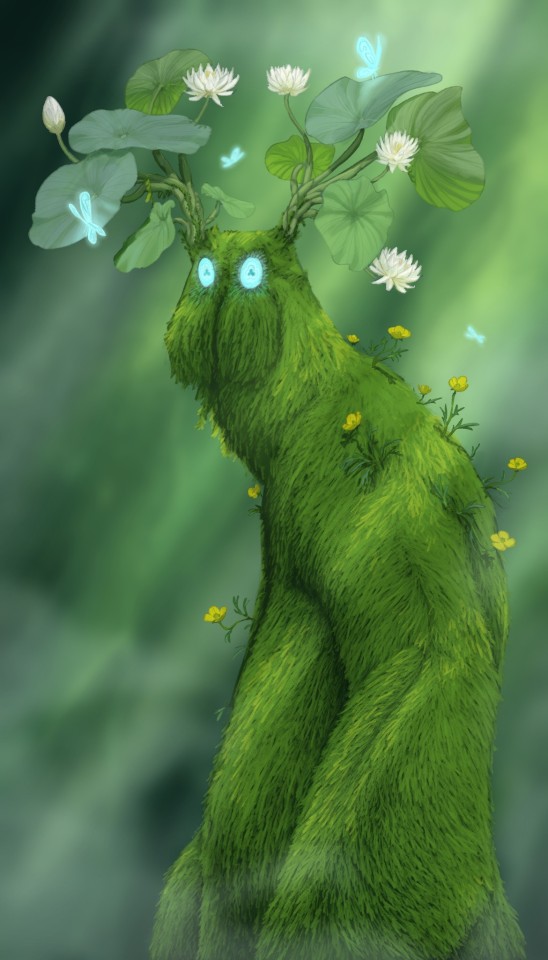
It has been a little more than a year since Amphibia ended, and I finished it again recently.
I got inspired and decided to make this piece, thank you Matt Braly et Al for this incredible series 💚🌿💚
18 notes
·
View notes
Text
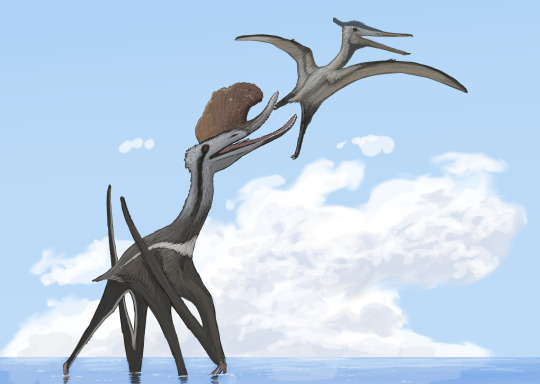

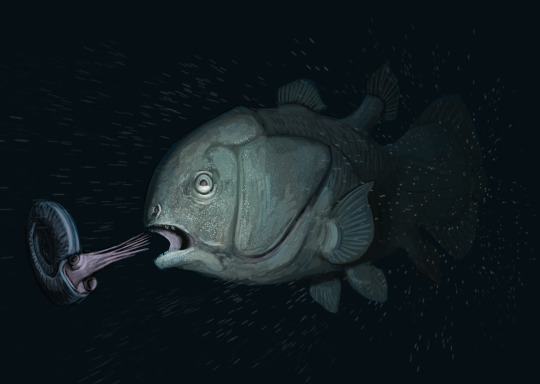
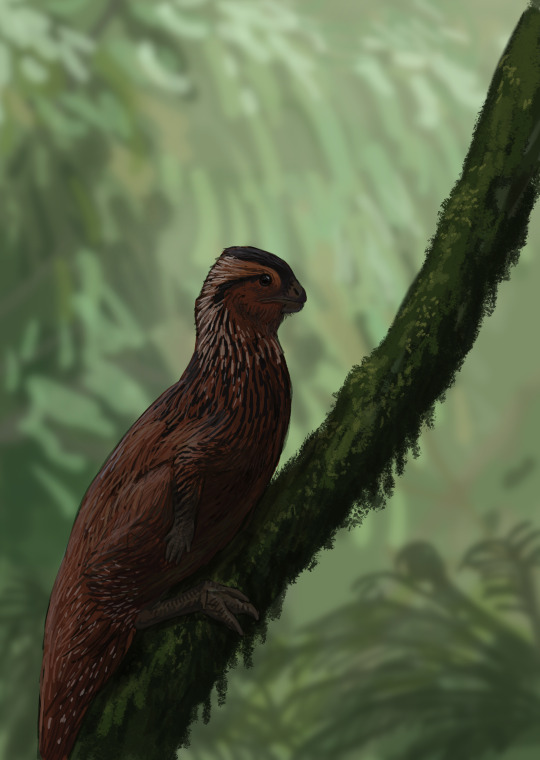
Results from the #paleostream Petrodactyle, Alligator munensis, Rieppelia and Minimocursor.
799 notes
·
View notes
Text

A bilateral gynandromorph ceratopsian, whose asymmetrical horns appear to complete a thin crescent moon
3K notes
·
View notes
Text
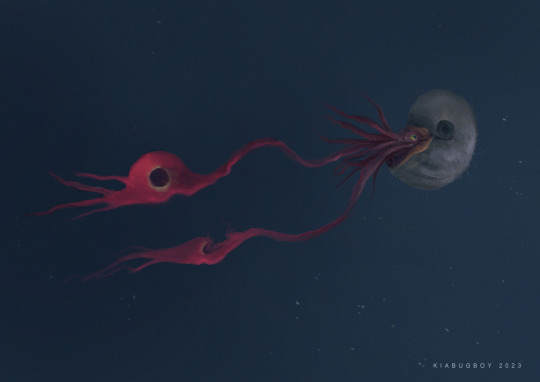
Can't remember if this idea has been done before, it's a sphaerocone ammonite with a speculative pair of tentacles that tear off easily, used as distraction for predators.
522 notes
·
View notes
Text
Salmonids of Artechocene Antarctica:
While thawing, the glaciers of Antarctica created an abundance of meltwater streams that now feed countless kilometres of freshwater ecosystems. At first nothing more than insect larvae and some crustaceans called these new environments home, but eventually fish entered the equation and quickly dominated.
One group of these fish were salmonids coming from South American coasts, descendants of invasive species such as the brown trout. They weren't the first, but they were much better at filling a lot of niches than the native Nothotenioids, which lacked hemoglobin and swim bladders.
And so they almost outcompeted these to extinction, and diversified into several genera classified roughly in three distinct groups: Helaks, Helerrets, and Valhallaks.

Most of the Helaks species are amongst the largest predators of the continent, and the Golden Helaks (Gjollsalmo fulgens) is the largest of them all, measuring up to 2 meters (7ft) long and more than 100kg (250lb) in weight. They're apex predators, using their size to block scape routes for prey fish of any size and swallowing them whole, preventing them from scaping thanks to its huge backwards facing teeth. They're also known to eat crustaceans and even birds that venture too deep into the water. They live in every waterway across Antarctica, with the adults being confined to the deeper canals and lakes.
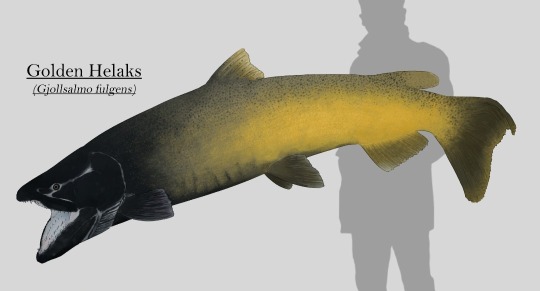
Helerrets are the most common salmonids that can be found in the rivers, lakes and wetlands of the continent. These medium sized predators mainly feed on the abundance of mollusks and other hard shelled invertebrates, as well as smaller vertebrates occasionally. This diet is enabled by their strong jaws, combined with blunt teeth that can crack open the shells of most freshwater invertebrates in their habitats. They're also the only Antarctic salmonids that retain the anadromous habits of its ancestors, living in freshwater but migrating to coastal waters to reproduce and release their young into the rich waters of the Southern Ocean.
The Bullheart Helerret (Slidrsalmo oatensis) in particular is native to the drainage basins that flow into Oates bay, where members of this species comes to spawn.
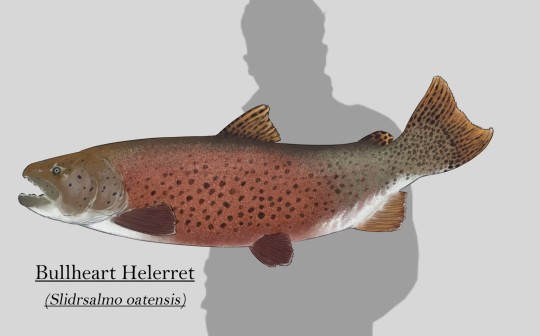
Valhallaks are a group of salmonids with remarkable sexual dimorphism compared to their close relatives. They are typically found in shallow rivers all across the continent, where they feed on invertebrates and vegetation.
Although not as common as Helerrets, they are abundant, specially in alpine streams and lakes during the end of the summer, where they come to spawn, away from predators so their eggs are protected by ice during the winter.
The Bearded Valhallaks (Valholsalmo auratops) specifically is endemic to the Vostok river drainage basin, which originates in Vostok Lake where they reproduce.
Range of the species featured:
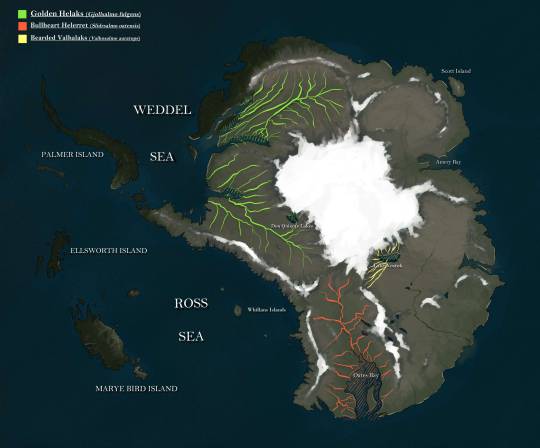

67 notes
·
View notes
Text
Remember that wheel I posted like half a month ago? I finally finished it!!

Now here's some close-ups with the characters that are featured in it :>
Red section!! Featuring Garnet from Steven Universe, Red from The Sea Beast, Hornet from Hollow knight, the Scarlet Caviearer from Bivaltopia and a pointy creature by Equiëtum ❤️🍄❤️

Orange section!! Featuring Calcifer from Howl's Moving Castle, Enoch from Over the Garden Wall, The Core from Amphibia, Rahang Besar from Project Temere and the Pomegranate King by Miguel11to.

Yellow section!! Featuring Bill Cipher from Gravity Falls, Jake the Dog from Adventure Time, the Plasm Wraith from Pikmin 3, the protagonist of Abzū, the Pangaloon from The New Dinosaurs and Amphinatans mirabilis from Polinices 💛🌟💛
Green section!! Featuring Kermit the Frog, Diamondhead from Ben 10, Link from Skyward Sword, Tighnari from Genshin Impact, the Emerald Bombardier from the Dragonslayer Codex and a Samara Fairy by samuelele_draws 💚🍀💚
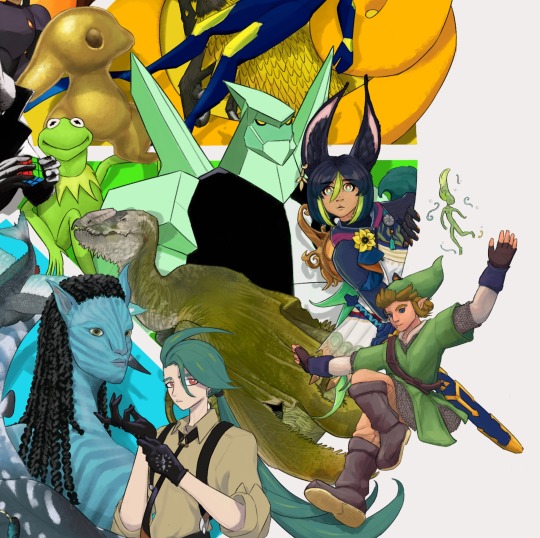
Cyan section!! Featuring Rika from Pokémon, a Na'vi from Avatar, the Flish from The Future is Wild, the Giant Severateel from Sinedey and Furcagnathodon from the Kiatra project 🩵🐬🩵
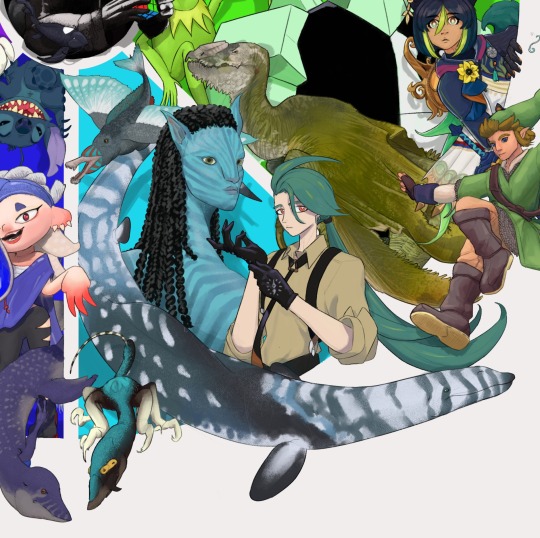
Blue section!! Featuring Stitch, Modecai from Regular Show, Shiver from Splatoon 3, Dory from Finding Nemo, the Inkilatura from Tales of Kaimere and an aquatic sapient from Scylios 💙🌀💙
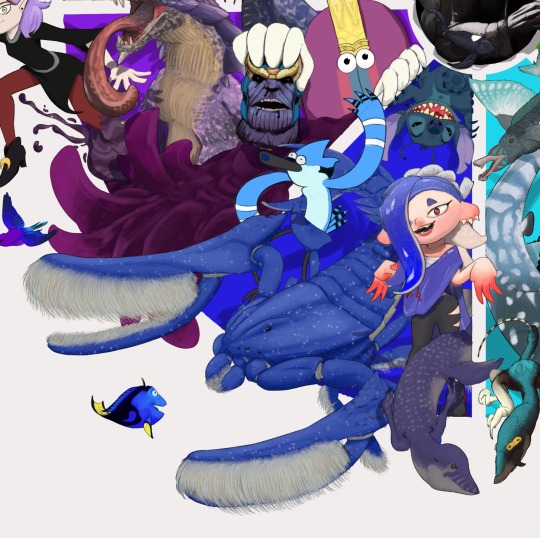
Purple section!! Featuring Amity Blight from The Owl House, Chameleos from Monster Hunter, Double King by Felix Colgrave, Thanos, the Amoebic Sea from Darwin IV and the Violet Bunting from the Birds of Novasola 💜👾💜

Pink section!! Featuring Nimona, Al-An from Subnautica: Below Zero, Kanroji Mitsuri from Demon Slayer, Perfuma from She-ra, an Axolotl from Minecraft and Apocleavis magnifica from the The Future is Far project 🩷🌸🩷


The B/W and final section!! Featuring Tui and La from Avatar: The Last Airbender, Spiderman Noir from Spiderman: Into the Spiderverse and Umbragrus huxlwyi from the Dragons of the World project 🖤🐧🤍

Hope you like it, took me like a month to finish :")
#art#illustration#speculative evolution#clip studio paint#creature design#pokemon#genshin impact#steven universe#hollow knight#amphibia#over the garden wall#studio ghibli#gravity falls#abzu#pikmin#the legend of zelda#avatar#splatoon#monster hunter#the future is wild#the owl house#demon slayer#she ra and the princesses of power#subnautica#nimona#minecraft#the sea beast#avatar the last airbender#across the spiderverse
522 notes
·
View notes
Text




Results from the #paleostream Guidraco, Indohyus, Grandemarinus, Machaeroprosopus.
452 notes
·
View notes

